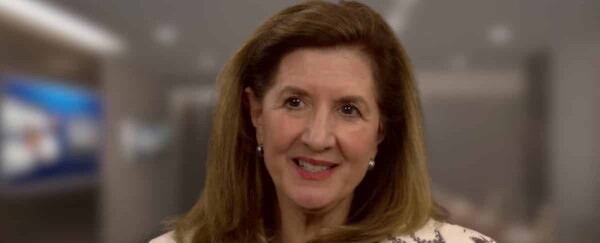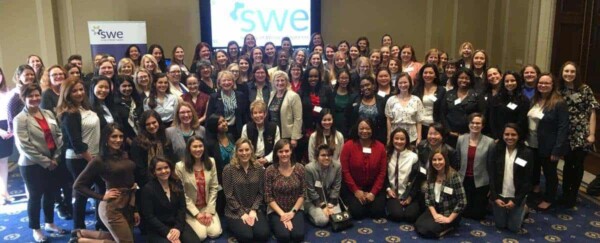Troy Eller English: Welcome to SWE Stories: Tales From the Archives episode 3: Nevertheless, She Persevered. I’m Troy Eller English, archivist for the Society of Women Engineers, based at the Walter P. Reuther Library of Labor and Urban Affairs at Wayne State University.
Anne Perusek: And I’m Anne Perusek, SWE’s Director of Editorial and Publications. It’s spring 2018 and we’re in the midst of a powerful cultural movement. There’s a purging of experience, emotions, and anger as seen in the #MeToo and #TimesUp movements. These are long-overdue responses to sexual harassment. Today we’re discussing gender-based discrimination experienced by women engineers. These two things, sexual harassment and gender-based discrimination, are closely related because at the root of these experiences is the erroneous notion that somehow women are less than men. And the balance of power and mindset that accompanies this is manifested in a variety of ways. Gender-based discrimination and harassment in the workplace takes many forms. Some actions are blatant and easily-identified. Some are subtle and harder to confront.
Eller English: So, many SWE members have shared their own experiences confronting gender-based harassment in the workplace. So many members have shared their stories, actually, that we’re recording two episodes. Today, we’ll share a few members’ experiences with brazen and flagrant harassment and discrimination. And the following episode will feature stories about more subtle or ambiguous harassment. Despite the heavy nature of the topic, please know that these stories are ultimately ones of empowerment. Certainly, women facing harassment in the workplace may not always have a positive story to tell at the end of the day. But today, we’re featuring stories of women who confronted and ultimately persevered over workplace harassment.
Perusek: SWE Fellow and Trustee Dorothy Morris shared her experience with SWE archivist Lauren Kata in a 2003 oral history interview. In the late 1950s Dorothy was working as the general manager at Colvin Laboratories, which was highly unusual for women to hold such a position in management. Colving Laboratories was under negotiations to be sold. In 1958 Dorothy was instrumental in all the negotiations handling the sale with the two companies. One company that was interested, Victory Engineering, eventually passed on the deal, and so Colvin Laboratories was bought out by a company called Spartan Industries. During her oral history interview, Dorothy explained what happened the day following the deal closure.
[Audio excerpt from oral history interview]
Dorothy Morris: And I went to work, you know, the next day. And I remembered so well it was the last day before Memorial Day weekend. And I walked into my office, and I was there only a short time when the telephone rang. And it was John Smith, who was the president of the company that had just acquired us. And he said, “As I’m talking to you on the phone,” he said, “My deputy will walk into your office, and will observe you as you clean out your desk.”
And I was rather taken back, of course. And he said, “I won’t even commit a female to be a draftsperson in my companies.” And he would openly admit it. And this man walked in, and so on and so forth.
And I remember calling Charles Colvin on the phone, and I said, “I’ve just been dismissed.” And of course, he was, you know, shocked. And he had had a contract to continue on with Spartan for about — I don’t know, a year or eighteen months. And so I left that day without a job, and I was devastated.
Lauren Kata: I can imagine. You’d put so much into —
Dorothy Morris: Yeah. And there’s two endings to the story. The interesting thing is that Charles Colvin found a way to break his contract, so he did not stay for the year or so with Spartan. And other people who had assumed that they would stay, employees, were so shocked at what happened to me that they left. And the whole thing became a disaster for Spartan Industries, because the key people didn’t — wouldn’t stay. That was it.
And I was at home the following week, feeling very badly, when I received a call from the office saying that the president of Breeze and Victory Engineering had called and wanted my home phone number when he found that I was no longer there. And they wanted permission to give it to him, and I said, “Okay.” And the reason he wanted my home phone number is that apparently he was impressed with the way I handled the negotiations, and he wanted me to come in and become treasurer of Victory Engineering Corporation. So I had a job without looking for one within a very short time. And I ended up being general manager of that company.
[End of excerpt]
Perusek: There’s so many things about that story that I really love, particularly the fact that out of disaster came a wonderful experience where Dorothy Morris was able to progress, become general manager of that company, be in an atmosphere that was free of the bias that her previous employer was showing, etcetera, etcetera. And I think there are so many lessons about trusting your own skills, your abilities, your expertise, the importance of building an network of supporters. And, it’s a pretty shocking story. It happened fully sixty years ago and it might be easy to discount her experience as a relic of a bygone age. However, members have shared recent experiences of gender discrimination and harassment taking place today.
Eller English: Yeah, so last fall during the WE17 Annual Conference, SWE member Pamela Dingman shared with me her recent and very public experience with gender-based discrimination.Back in 2013, Pam owned a very successful civil engineering company in Nebraska and served on her city’s planning commission.She attended the WE13 Annual Conference, where she was receiving SWE’s Entrepreneur Award for her success in leading and growing her company, Engineering Design Consultants, or EDC.
So, while she was at the conference celebrating her success as an entrepreneur, she actually made the decision to give it all up. The Lancaster County Engineer in Nebraska had recently announced his resignation and the county commissioners intended to appoint someone to fill the position until elections could be held in the spring of 2014. So, Pam knew that by seeking the appointment she was effectively firing herself from her own company, but she had always wanted to pursue public service and decided that both the timing and opportunity were right.
So, she submitted her application while she was at the conference, and she was ultimately appointed Lancaster County Engineer in December 2013. She intended to formally run for the office in the spring of 2014, in the elections that would be held just a few months later. Pam explained in her oral history interview the resistance she met even before she began her first day on the job.
[Audio excerpt from oral history interview]
Pamela Dingman: In the weeks before that, I had continued to try to meet with my predecessor, and he had really set up a true good old boy system that he had recommended, that someone who had worked for him for 26 years take his spot, and so they were really mad that that gentleman was not selected. And so, when I would try to get ahold of him to make a transition plan, he — well, the first time he — I called him, I said, “Hi. I’m Pam Dingman, and I’d really like to schedule a meeting with you to discuss a transition plan,” and he hung up on me. (laughs) And so, I just called back the second day, and I said, “Hi. My name’s Pam Dingman. I really want to talk to you about a transition plan, and we must have gotten disconnected yesterday,” and he says, “We didn’t get disconnected. I hung up on you,” and he said, “I’m not interested in meeting with you. I’m not interested in a transition plan.” And I’m thinking, oh, this is a big organization. This is a problem.
So, the third day, I call and I say, “Hi. It’s Pam again. I was just wondering when I could come in and meet with you,” and he said, “You’re not going to give up, are you?” and I said, “As a matter of fact, I’m not.” And so, he scheduled a meeting with me, and I came in and I talked to him about what all my concerns were with transitioning the organization, which, at the time, was an over-20,000,000- dollar-a-year annual budget, with about 110 employees. And what’s interesting is, I started asking my questions, and he said, “I’m really done answering your questions, and I’m not interested in helping you be successful in any way,” and he went over to his desk, and he turned his chair away from me. And I remember just, I kept asking the questions across the room; I was just not going to be dismissed.
[End of excerpt]
Eller English: So, Pam began her appointment as county engineer in December 2013, but the 26-year veteran of the department and many others were not happy that she was there and they were not particularly keen on following the policies and efficiencies she wanted to pursue as the county engineer. So, both Pam and that 26-year veteran of the department decided to run in what became a contentious and volatile election.
[Audio excerpt from oral history interview]
Dingman: I didn’t necessarily anticipate that it would be as hard as it was, or that it would be as personal as it was, and there were things like letters to the editor written. One in particular that was written by an ex-City of Lincoln—a retired employee—the gentleman wrote that he had worked with both candidates and that I was inferior, basically, in every way. I mean, it was published in a paper. You’re like, Oh my goodness. There was one article—and I think this person meant this article to be hurtful to me, but it didn’t really work out that way for him —and he wrote that, he basically wrote he didn’t know me, and he didn’t know why I would have been appointed, and I had no reason to be county engineer. Very dismissive. “I don’t know her, I don’t know why the commissioners picked her, and—.” Just along the lines of, I had no right. And what’s interesting is, his letter was so—when I first read the letter, I’m like, Well this is horribly dismissive and sexist. And then I thought, Okay, put on your big girl pants, flush your emotional toilet, you don’t really have time to waste, and you’re probably just being sensitive. So just come on, keep your eye on the prize, you don’t have time to waste time on this.
And what’s interesting is, people sent me letters—other women engineers who knew me, one in particular sent me a letter about, “Hey, listen, I read this. It was completely inappropriate, and here’s my donation to your campaign, and beat this guy. Beat him for all of us.” And so, I actually got thousands of dollars in donations off this guy’s really nasty letter to the editor, which you know was not his intent to empower me. And so, what’s interesting about becoming county engineer and the whole campaign is, as it went on, it really was a very sexist campaign, kind of along the lines of, she can’t do this, what’s a woman doing here. And as I kept campaigning, and I kept out there in the public, what was really more interesting to me is how much it wasn’t about me at all anymore, but that I had to win for the local women to really feel empowered.
And I was at my EDC office one afternoon working, and this young woman stops into my office, and I recognize her from the coffee shop. And she says, “I knew you from the coffee shop, but I didn’t really know who you were. And after you left today there were some people at the coffee shop, and they were talking about how you shouldn’t be county engineer—that a woman shouldn’t be county engineer. They didn’t think it was right. And, I just wanted to stop by, and this is my tip money.”
And she gives me like 10 dollars in change, and obviously this woman—it really didn’t—I really didn’t want to take her 10 dollars in change. I was just so humbled by it, but she just insisted that she wanted to donate to my campaign and support my campaign, and could she have signs and—Pam Dingman for Engineer signs. So, it was just —it was such a humbling moment to know that the journey wasn’t just about me anymore. The journey was really about taking Lancaster County and getting up to the next level.
And, as I knocked on doors, I remember a gentleman that said to me, “Lady, are you even an engineer?” (laughs) And I said, “Well, yes, I am an engineer.” And he goes, “Do you have an engineering license?” And I said, “Well, as a matter of fact, to file to run for county engineer, I had to show my license to the election commissioner, so yes, I am licensed.” And he goes, “And what’s your license number?” And I’m like, Oh my gosh, where’s this going to end? And I tell him what my license number is, and he kind of sits back, and he says, “Do you know Paula Wells?” And Paula Wells, of course, was documented as one of the Women Engineers You Should Know [in theSWE Magazine]. She’s a 1960 graduate from the University of Nebraska, Lincoln, and one of the first women in Lincoln to—in Nebraska, to have an engineering license. And so, I said, “Well, I do know Paula Wells.” And he says, “She’s a little strange, but I’ll vote for you.” (laughs) And I was like, where do the questions end? But with this gentleman, the questions ended with, Okay, now you don’t know one woman engineer. You know two. So we’ve increased your realm by 100 percent, and we’re going to keep pushing the bar forward.
[…] And I remember the day after the election, I had a staff meeting, and it was the saddest staff meeting (laughs) I’ve ever had in my whole life, because, God bless these people, but they never imagined that I would actually win. And I never imagined that I would actually lose, because I put everything I had into winning.
[End of excerpt]
Eller English: So, I think Pam’s story is a wonderful example that even though you confront skepticism, hostility, or harassment, if you confront it and overcome it, you make the path just a little easier for the next woman engineer behind you. I think it’s common or easy to assume that women engineers have already tread that path, and that most women won’t face such obvious and devastating discrimination and harassment in the workplace. But Pam’s experience is only five years old. That happened just five years ago.
SWE Magazine has conducted a review of literature for the past 16 years and SWE is also engaged in research on a number of issues, including the environment for women in engineering. Anne, can you share some insight from that research?
Perusek: Oh, certainly. So as you said, for sixteen years we’ve done annual literature review on the social science literature that is examining the status of women in engineering. Consistently, one thing we see over the years is that the emphasis is mostly on women in academic spheres. So, it’s either the experience of students or women who are in the professorate. There’s just such a shortage of studies on women in industry. They are there, but they are few and far between.
I think probably the easiest way to summarize it would be to say the experience of women in engineering and certainly in these areas of discrimination and harassment, we wonder how does this change and it’s a little bit of the chicken and the egg. Do women not enter the field or leave the field because of the persistence of male dominance? So, if that’s the case, what would change it to put more women in the field? So it’s a little bit of vicious cycle. We do have some specific study results regarding work/life issues and things like that would contribute to women’s low representation in the field. But to actually study the culture of engineering requires a little broader scope than sometimes have found in the social science research. And it’s one of the reasons why we call every year for more research on women in industry.
Eller English: So, there’s a question of what you should do if you experiencing discrimination and harassment in the workplace. I very much wanted to include a segment that was recorded during a 2008 StoryCorps interview with SWE member Mary Anderson-Rowland. In 2008 she shared with me how Jan Elsea, a colleague in the Faculty Women’s Association at Arizona State University in the 1970s, took matters into her own hands, literally, when she had it with the sexual harassment in her department.
[Audio excerpt from oral history interview]
Mary Anderson-Rowland: Jan Elsea, I think, put the courage into all of us. She talked about the discrimination that she faced in her department, because the faculty men were hanging up pictures of pinups––women pinup girls––around. And she said that she felt uncomfortable about that, and she didn’t think the women students appreciated it either. So what she decided to do is she hung up a very bare man on her office and within days all the pictures came down.
And so, I think one of the things you really learn is you have to attack things with a sense of humor. And this you may want to cut, but I will tell another story about Jan Elsea is that there was a male colleague that she had that every time he walked by her he would give her a little tap on her fanny. And she did not appreciate that. And so, she told him, “Do not do that anymore, and if you do there will be consequences.” And so, the next time he came by and gave her a little tap, she turned and grabbed him right in front. And that was the end of that.
[End of excerpt]
Eller English: So, while that resolution might be very satisfying, your HR department will certainly say that it shouldn’t be repeated, and SWE does not advise that response. So, Anne, what should you do?
Perusek: Well, first of all, the National Women’s Law Center does have resources on how to identify and respond to things like pay inequity, workplace harassment and discrimination that based on gender, pregnancy, and family. That would be a good place to start.
SWE also has great resources, not just for dealing with harassers, but also for transforming your workplace into one that does not tolerate harassment. You can access SWE’s Advanced Learning Center modules to learn more about that. If you want to help foster a harassment-free workplace, be sure to read SWE’s Diversity and Inclusion Playbook, and check out SWE two card decks, now, on Diversity and Inclusion Knowledge, and Inclusion Solutions.
Also, there’s programming on avoiding and overcoming workplace harassment at the WE18 Annual Conference, at the WE Local conferences, and events sponsored by SWE sections around the U.S. and throughout the world. And finally, find SWE’s latest research on the workplace environment for women engineers on the SWE Research site, research.swe.org, and in the State of Women In Engineering issue of the SWE Magazine, which came out just in March. And that is available on the magazine app through Google Play and in the App Store, as hard copy through Amazon, and on the magazine page of SWE’s website under the archives.
Eller English: Alright, so we hope that you found some inspiration or courage from the stories that we shared from the archives today.The transcript to this episode will be posted on alltogether.swe.org, and there you’ll find links to the archival content as well as the resources we mentioned.
In the next episode, we’ll share stories from members about the more subtle discrimination or harassment that they’ve experienced and overcome. On behalf of myself, Anne, and everyone one else at SWE, thanks for listening.
Listen to our first two Tales from the Archives episodes on SoundCloud.
Transcripts from the first two episodes are on All Together.
Tales from the Archives Episode #2
Tales from the Archives Episode #3
***
RESOURCES
—From National Women’s Law Center—
Workplace Issues: https://nwlc.org/issue/workplace/
Frequently Asked Questions About Sexual Harassment in the Workplace: https://nwlc.org/wp-content/uploads/2016/11/Sexual-Harassment-FAQ.pdf
—From SWE—
Advance Learning Center – Diversity, Equity, Inclusion & Belonging Courses: https://advancelearning.swe.org/courses/42895
Diversity and Inclusion Resources: https://swe.org/learning/diproducts/
Research and Trends for Women in STEM: https://research.swe.org/
—From SWE Magazine—
A Compendium of the SWE Annual Literature Reviews on Women in Engineering: 16 Years of Analysis and Insight from SWE Magazine, 2001-2017: http://societyofwomenengineers.swe.org/images/swemagazine/SWE-Lit-Review-Compilation-2017.pdf
State of Women Engineering 2018: https://viewer.aemmobile.adobe.com/index.html#project/630f08d4-cacf-4cf0-bfb7-c77938722044/view/swe_main/view/swe-stateofwomen-2018
ARCHIVAL SOURCES
Anderson-Rowland, Mary, interviewed by Troy Eller, SWE StoryCorps Interviews, Walter P. Reuther Library and Archives of Labor and Urban Affairs, Wayne State University, [November 7, 2008].
Dingman, Pamela, interviewed by Troy Eller English, SWE Grassroots Oral History Project, Walter P. Reuther Library and Archives of Labor and Urban Affairs, Wayne State University, [October 26, 2017].
Morris, Dorothy, interviewed by Lauren Kata, Profiles of SWE Pioneers Oral History Project, Walter P. Reuther Library and Archives of Labor and Urban Affairs, Wayne State University, [May 19, 2003].
Author
-
![Podcast: SWE Stories - Tales From the Archives Episode 3 - Nevertheless She Persevered [] SWE Blog](https://alltogether.swe.org/wp-content/uploads/2021/10/swe-favicon.png)
SWE Blog provides up-to-date information and news about the Society and how our members are making a difference every day. You’ll find stories about SWE members, engineering, technology, and other STEM-related topics.






